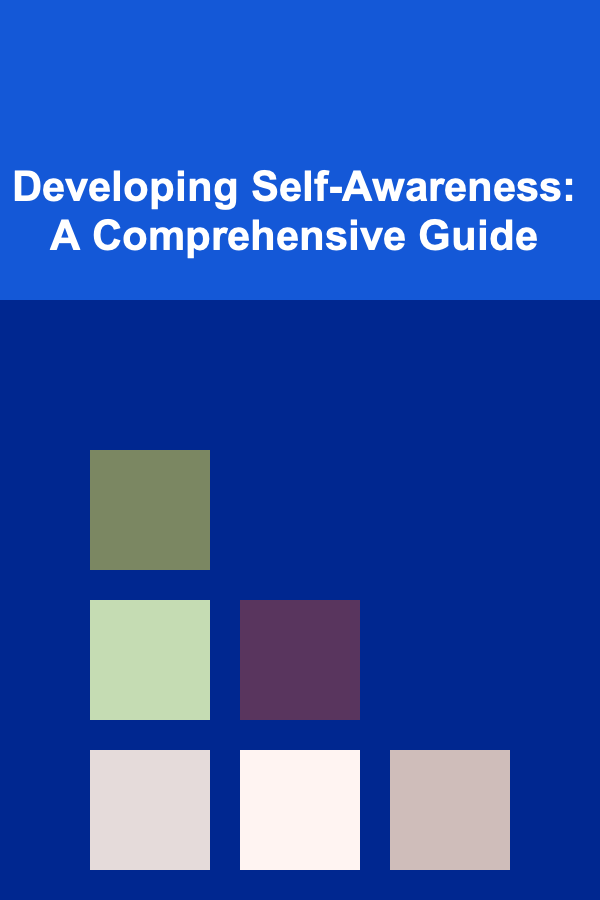
Developing Self-Awareness: A Comprehensive Guide
ebook include PDF & Audio bundle (Micro Guide)
$12.99$6.99
Limited Time Offer! Order within the next:

Self-awareness, often hailed as the cornerstone of personal and professional growth, is the ability to consciously know and understand your own character, feelings, motives, and desires. It's about understanding why you do what you do, how you react to certain situations, and what impact your behavior has on others. While seemingly straightforward, genuine self-awareness is a complex and ongoing process, requiring introspection, honesty, and a willingness to confront uncomfortable truths about yourself.
This in-depth guide explores the multifaceted nature of self-awareness, providing actionable strategies, practical exercises, and insightful perspectives to help you embark on a journey of self-discovery and cultivate a deeper understanding of who you are.
Understanding the Core Components of Self-Awareness
Self-awareness isn't a monolithic entity. It's composed of several interconnected components that, when understood and developed, contribute to a more holistic and accurate perception of oneself. These components include:
1. Emotional Awareness
Emotional awareness is the ability to recognize, understand, and accurately label your own emotions. It goes beyond simply acknowledging that you are feeling something; it involves identifying the specific emotion (e.g., anger, sadness, joy, anxiety) and understanding its underlying causes and potential triggers. Emotionally aware individuals are better equipped to manage their emotions effectively, make informed decisions, and build stronger relationships.
Developing Emotional Awareness:
- Practice Mindfulness: Mindfulness involves paying attention to the present moment without judgment. Regularly practicing mindfulness, through meditation or simply focusing on your breath, can help you become more attuned to your internal states, including your emotions.
- Keep an Emotion Journal: Record your daily experiences, paying particular attention to the emotions you experienced and the situations that triggered them. Note the physical sensations associated with each emotion (e.g., clenched fists when angry, butterflies in your stomach when anxious).
- Learn Emotional Vocabulary: Expand your emotional vocabulary beyond basic terms like "happy" or "sad." Use more nuanced words to describe your feelings, such as "frustrated," "disappointed," "resentful," or "content."
- Pause and Reflect: When you experience a strong emotion, take a moment to pause and reflect before reacting. Ask yourself: "What am I feeling? Why am I feeling this way? Is my reaction proportional to the situation?"
2. Self-Perception
Self-perception refers to your own beliefs, values, and opinions about yourself. It's how you see yourself, your strengths, your weaknesses, and your capabilities. This self-view is shaped by a multitude of factors, including past experiences, social interactions, cultural influences, and internal narratives. An accurate and balanced self-perception is crucial for self-acceptance and confidence.
Developing Self-Perception:
- Identify Your Core Values: What principles are most important to you? What do you stand for? Identifying your core values provides a framework for understanding your motivations and guiding your decisions.
- Challenge Limiting Beliefs: Examine your beliefs about yourself. Are they based on evidence or are they based on negative self-talk or past experiences? Challenge limiting beliefs by gathering evidence to the contrary and reframing them into more positive and empowering statements.
- Practice Self-Compassion: Treat yourself with the same kindness and understanding that you would offer to a friend. Acknowledge your imperfections and accept that you are not perfect.
- Focus on Your Strengths: Identify your strengths and talents and find opportunities to use them. Focusing on your strengths can boost your confidence and self-esteem.
- Seek Constructive Criticism: Ask trusted friends, family members, or colleagues for honest feedback about your strengths and weaknesses. Be open to hearing their perspectives, even if they are difficult to hear.
3. Understanding Your Motivations
Motivation is the driving force behind your actions. Understanding your motivations involves recognizing why you do what you do. Are you driven by intrinsic factors (e.g., a desire for learning, personal growth, or helping others) or extrinsic factors (e.g., money, recognition, or power)? Understanding your motivations can help you align your actions with your values and pursue goals that are truly meaningful to you.
Developing an Understanding of Your Motivations:
- Reflect on Your Choices: Analyze your past choices and ask yourself why you made those choices. What were you hoping to achieve? What needs were you trying to satisfy?
- Identify Your Values in Action: Observe your behavior in different situations and identify which values are being expressed through your actions. For example, if you volunteer regularly, it may indicate that you value service and compassion.
- Explore Your Passions: What activities do you enjoy doing? What topics are you naturally drawn to? Exploring your passions can reveal your underlying motivations and lead you to fulfilling pursuits.
- Use the "5 Whys" Technique: When you identify a goal or desire, ask yourself "Why?" five times. This technique can help you uncover the root causes of your motivations. For example: "I want to get a promotion." 1) Why? "Because I want more money." 2) Why? "Because I want to provide a better life for my family." 3) Why? "Because I value security and stability." 4) Why? "Because I grew up in a financially insecure household." 5) Why? "Because I want to break the cycle of poverty."
4. Recognizing Your Impact on Others
This component involves understanding how your behavior affects other people. It's about being aware of your communication style, your body language, and your overall presence, and how these factors influence the thoughts, feelings, and behaviors of those around you. This is sometimes referred to as "social awareness" as it relates to yourself. Developing this aspect of self-awareness requires empathy and the ability to see situations from different perspectives.
Developing an Understanding of Your Impact on Others:
- Seek Feedback from Others: Ask trusted individuals for honest feedback about how your behavior impacts them. Be specific in your requests, asking about particular situations or behaviors.
- Observe Your Interactions: Pay attention to how people react to you in different situations. Do they seem comfortable and engaged? Or do they seem withdrawn or uncomfortable?
- Practice Active Listening: Focus on truly understanding what others are saying, both verbally and nonverbally. Pay attention to their body language, tone of voice, and underlying emotions.
- Develop Empathy: Try to put yourself in other people's shoes and see the world from their perspective. Consider their experiences, their challenges, and their motivations.
- Be Mindful of Your Body Language: Nonverbal cues can have a significant impact on how others perceive you. Maintain eye contact, use open and welcoming body language, and avoid fidgeting or appearing distracted.
Strategies and Techniques for Enhancing Self-Awareness
Developing self-awareness is an ongoing process that requires consistent effort and a willingness to learn and grow. Here are some practical strategies and techniques you can use to enhance your self-awareness:
1. Journaling
Journaling is a powerful tool for self-reflection and self-discovery. It allows you to explore your thoughts, feelings, and experiences in a safe and private space. Regular journaling can help you identify patterns in your behavior, uncover hidden motivations, and gain a deeper understanding of yourself.
Tips for Effective Journaling:
- Choose a journaling method that works for you: You can use a physical notebook, a digital document, or a journaling app.
- Set aside a specific time each day for journaling: Consistency is key to reaping the benefits of journaling.
- Write freely and honestly: Don't censor yourself or worry about grammar or spelling. Just let your thoughts flow onto the page.
- Use prompts to guide your writing: If you're not sure what to write about, use prompts such as: "What am I grateful for today?" "What challenges am I facing?" "What are my goals for the future?" "How did I react to [specific event] and why?"
- Review your journal entries regularly: Look for patterns, insights, and areas for growth.
2. Mindfulness Meditation
Mindfulness meditation involves paying attention to the present moment without judgment. By focusing on your breath, your body sensations, and your thoughts, you can become more aware of your internal states and cultivate a greater sense of self-awareness. Regular mindfulness meditation can also reduce stress, improve focus, and enhance emotional regulation.
Tips for Practicing Mindfulness Meditation:
- Find a quiet and comfortable place to sit or lie down.
- Close your eyes or soften your gaze.
- Focus your attention on your breath. Notice the sensation of the air entering and leaving your body.
- When your mind wanders, gently redirect your attention back to your breath.
- Start with short meditation sessions (e.g., 5-10 minutes) and gradually increase the duration as you become more comfortable.
- Use guided meditations to help you focus your attention. There are many free guided meditation apps and resources available online.
3. Seeking Feedback
Seeking feedback from others is an essential part of developing self-awareness. It provides you with an external perspective on your behavior and helps you identify blind spots. When seeking feedback, it's important to choose trusted individuals who are willing to provide honest and constructive criticism.
Tips for Seeking Effective Feedback:
- Choose the right people to ask for feedback: Select individuals who know you well, whose opinions you respect, and who are willing to provide honest and constructive criticism.
- Be specific in your requests: Ask for feedback on particular behaviors or situations. For example, "I'm working on improving my communication skills. Can you give me feedback on how I presented my ideas in the last meeting?"
- Listen actively and without judgment: Focus on understanding the other person's perspective. Don't interrupt or become defensive.
- Ask clarifying questions: If you don't understand something, ask clarifying questions.
- Thank the person for their feedback: Show appreciation for their time and effort.
- Reflect on the feedback you receive: Consider the validity of the feedback and how you can use it to improve your behavior.
4. Personality Assessments
Personality assessments, such as the Myers-Briggs Type Indicator (MBTI), the Enneagram, and the DISC assessment, can provide valuable insights into your personality traits, preferences, and behavioral tendencies. While these assessments should not be used to label or limit yourself, they can be helpful tools for understanding your strengths, weaknesses, and potential areas for growth.
Considerations for Using Personality Assessments:
- Choose reputable and validated assessments: Ensure that the assessment you choose is reliable and accurate.
- Interpret the results with caution: Remember that personality assessments are just tools for self-exploration. Don't take the results as definitive or absolute truths about yourself.
- Focus on using the results to understand your strengths and weaknesses: Use the assessment results to identify areas where you can improve your behavior and enhance your relationships.
- Avoid using the results to label or limit yourself: Your personality is not fixed. You have the ability to learn and grow and change your behavior.
5. Self-Observation
Self-observation involves consciously observing your own thoughts, feelings, and behaviors in different situations. This can be done through journaling, mindfulness meditation, or simply paying attention to your internal and external experiences throughout the day. Self-observation can help you identify patterns in your behavior, uncover triggers, and gain a greater understanding of your reactions.
Tips for Effective Self-Observation:
- Choose a specific behavior or situation to observe: Focus on one aspect of your behavior at a time. For example, you might choose to observe your reactions to stressful situations or your communication style in meetings.
- Record your observations in a journal or notebook: Note the specific details of the situation, your thoughts, feelings, and behaviors.
- Look for patterns in your observations: Are there any common triggers or patterns in your behavior?
- Analyze your observations: What can you learn from your observations? What changes can you make to improve your behavior?
- Be patient and persistent: Self-observation takes time and effort. Don't get discouraged if you don't see results immediately.
6. Challenging Your Assumptions
Many of our thoughts, feelings, and behaviors are based on assumptions that we may not even be aware of. Challenging these assumptions can help us gain a more accurate and balanced perspective on ourselves and the world around us.
How to Challenge Your Assumptions:
- Identify your assumptions: What assumptions are you making about yourself, others, or the situation?
- Question the validity of your assumptions: Is there any evidence to support your assumptions? Are there alternative explanations?
- Gather evidence to the contrary: Look for evidence that contradicts your assumptions.
- Reframe your assumptions: Rewrite your assumptions in a more positive and empowering way.
The Benefits of Enhanced Self-Awareness
Investing in the development of your self-awareness yields numerous benefits, both personally and professionally. These benefits include:
- Improved Decision-Making: Self-aware individuals are better able to make informed decisions that are aligned with their values and goals.
- Enhanced Emotional Intelligence: Self-awareness is a key component of emotional intelligence, which enables you to manage your emotions effectively, empathize with others, and build strong relationships.
- Increased Confidence: Understanding your strengths and weaknesses can boost your confidence and self-esteem.
- Improved Communication: Self-aware individuals are better able to communicate effectively and build rapport with others.
- Stronger Relationships: Self-awareness allows you to be more present, empathetic, and understanding in your relationships.
- Reduced Stress and Anxiety: By understanding your triggers and managing your emotions effectively, you can reduce stress and anxiety.
- Increased Creativity: Self-awareness can unlock your creativity by allowing you to tap into your intuition and express yourself authentically.
- Greater Fulfillment: Living in alignment with your values and pursuing your passions can lead to a more fulfilling and meaningful life.
- Improved Leadership Skills: Leaders who are self-aware are better able to inspire and motivate their teams, build trust, and create a positive work environment.
- Better Conflict Resolution: Understanding your own reactions and triggers during conflict allows for more effective communication and finding mutually agreeable solutions.
Potential Pitfalls and How to Avoid Them
While the journey to self-awareness is generally positive, there are potential pitfalls to be aware of:
- Overthinking: Excessive introspection can lead to overthinking and analysis paralysis. It's important to balance self-reflection with action. Solution: Set time limits for self-reflection and focus on taking small, concrete steps based on your insights.
- Becoming overly critical of yourself: Self-awareness should not turn into self-criticism. It's important to practice self-compassion and accept your imperfections. Solution: Actively practice self-compassion exercises and remind yourself of your strengths.
- Using self-awareness as an excuse: Understanding your weaknesses should not be an excuse for poor behavior. It's important to take responsibility for your actions and work to improve. Solution: Focus on actionable steps to address your weaknesses and hold yourself accountable.
- Defensiveness: Hearing feedback from others can be difficult. Avoid becoming defensive and instead, be open to learning from their perspectives. Solution: Practice active listening and remind yourself that feedback is an opportunity for growth.
- Thinking self-awareness is a destination: Self-awareness is a journey, not a destination. It's an ongoing process of learning and growth. Solution: Embrace the process of continuous self-discovery and be open to new insights.
Conclusion
Developing self-awareness is a lifelong journey that requires commitment, courage, and a willingness to learn and grow. By understanding the core components of self-awareness, utilizing effective strategies and techniques, and being mindful of potential pitfalls, you can cultivate a deeper understanding of yourself and unlock your full potential. Embrace the process, be patient with yourself, and celebrate your progress along the way. The rewards of enhanced self-awareness are well worth the effort, leading to a more fulfilling, meaningful, and successful life.

How to Build an Emergency Fund for Financial Security
Read More
How to Make a Checklist for Cybersecurity and Data Protection in an Emergency
Read More
How to Regularly Inspect and Maintain Your Home's Smoke Detectors
Read More
Why You Should Reassess Your Storage Solutions Regularly
Read More
Forest Bathing: A Deep Dive into Practicing Shinrin-Yoku for Health
Read More
10 Tips for Choosing the Right Structural Engineering Software
Read MoreOther Products

How to Build an Emergency Fund for Financial Security
Read More
How to Make a Checklist for Cybersecurity and Data Protection in an Emergency
Read More
How to Regularly Inspect and Maintain Your Home's Smoke Detectors
Read More
Why You Should Reassess Your Storage Solutions Regularly
Read More
Forest Bathing: A Deep Dive into Practicing Shinrin-Yoku for Health
Read More